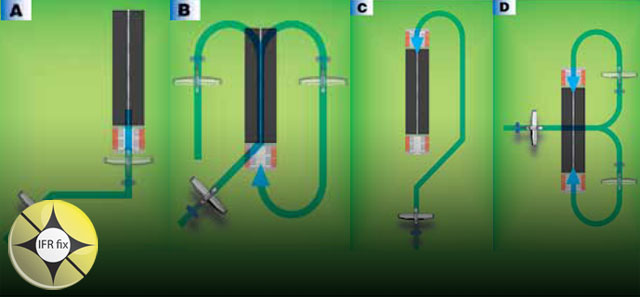
Photo credit: FAA Instrument Flying Handbook
It’s dark. You’re tired. Clouds are low, and your fuel isn’t high.
This is your first-ever approach to the destination airport, and it’s a relief to hear that you can expect to break out with altitude to spare.
The motel has Wi-Fi and a pool. So why the long face?
Here’s the catch: Before you get on the ground, you are going to have to confront an old adversary: Pattern B.
One idea that emerges fairly clearly about instrument pilots is that the prospect of flying a real-world circling approach triggers considerable avoidance. Give pilots a plausible alternative, and circle-to-land loses.
The apparent aversion targets serious circling approaches—not the circling procedures in name only that fall a few degrees out of alignment from being straight-in. Think of Pattern A in Chapter 10 of the Instrument Flying Handbook.
It’s not conclusive, but it was compelling to note that given the choice of landing straight-in on a (very) long runway in a 10- to 20-knot tailwind, or circling to land, 982 (53 percent) of 1,837 who responded to the Nov.23, 2011, “IFR Fix” poll chose a straight-in landing.
Wow, that’s a lot of tailwind. But pilots didn’t shrink from it, given the alternative of circling at minimums. That approach called for Pattern C, not the more drawn-out and maneuver-laden Pattern B.
At airports with one approach course roughly perpendicular to the runway, Pattern D is the usual call. Fly it left or right as befits the choice of landing direction.
The good news? You won’t fly most circling approaches at minimums.
In fact, please don’t. When ceilings allow, the FAA urges pilots to circle at an altitude “that more nearly approximates” VFR traffic patterns. (Watch for VFR traffic.) Some instrument pilots head instinctively for minimums—a remnant of rote from the rigors of training, perhaps. Does that (and little real practice) fuel their aversions?
Thanks to NextGen, there’s a proliferation of instrument approaches serving multiple runways occurring at ever more airports. That hints at a future when circling approaches could become as rare as a DF steer is today, if you remember the almost sci-fi method flight service used when helping lost VFR pilots find the way.
Until then, circling approaches remain a resource, helping IFR aviators recognize their limits, in a roundabout way.



